Exploring Inline Square Balers for Modern Farming
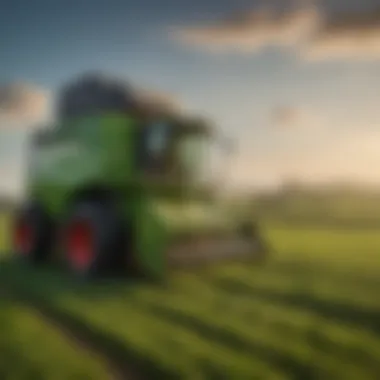
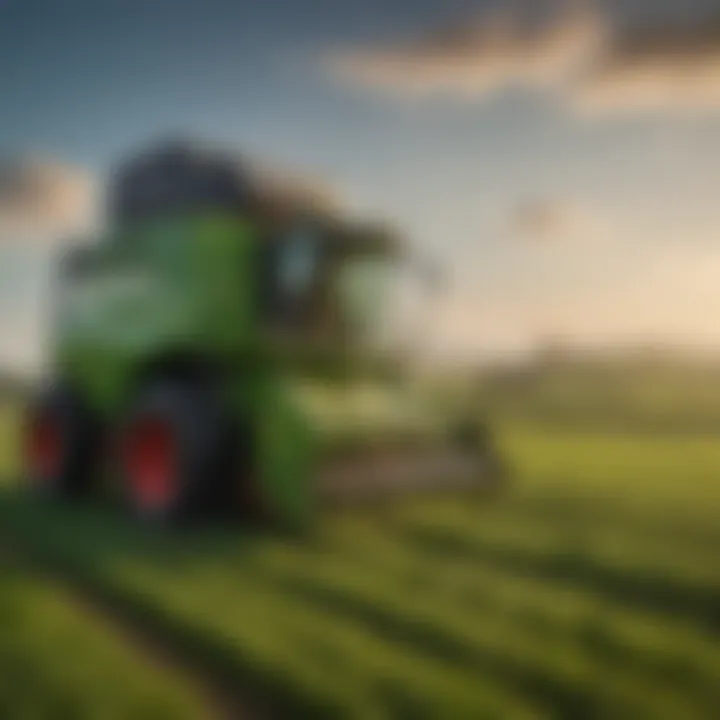
Intro
In the fast-paced world of modern agriculture, inline square balers play a crucial role in streamlining hay and straw harvesting. As farming techniques evolve, understanding these machines becomes increasingly vital for optimal productivity.
Inline square balers are engineered to handle various crops, allowing farmers to produce neatly packed bales that are easy to transport and store. Their efficiency can significantly impact a farmer's bottom line, making it essential to grasp their design, functionality, and recent advancements. In this guide, we will delve deep into the inner workings of inline square balers, showcasing their importance in today’s agricultural landscape.
Topic Overview
Definition and Importance
Inline square balers are specialized equipment used to convert loose materials like hay, straw, and forage into compact, manageable bales. The design allows the intake and compression of the crop to occur inline. This setup enables continuous operation, increasing efficiency and reducing labor costs. Each bale produced serves as not just a convenient storage solution but also contributes to better resource management and minimal wastage.
Brief History and Evolution
The journey of balers dates back to the 19th century when manual processes dominated harvesting. Early machines were cumbersome, heavily relying on manual labor for operation and maintenance. Over the years, technology progressed. The introduction of mechanized balers revolutionized the industry, enabling farmers to work more swiftly and efficiently.
In line with technological advancements, inline square balers emerged, showcasing enhanced features such as automatic tie systems and improved feed mechanisms. These innovations have led to significant developments in harvest speed and quality management, allowing farmers to maximize their yield without sacrificing quality.
Key Techniques and Innovations
Sustainable Farming Practices
Sustainability is at the forefront of modern agriculture, and inline square balers significantly contribute to green practices. The precision with which they handle crops minimizes nutrient loss, and their efficient design reduces fuel consumption compared to traditional methods. Examples of sustainable practices include:
- Reduced Soil Compaction: Inline balers distribute weight evenly, helping to maintain soil health.
- Improved Crop Rotation: The efficiency allows farmers to rotate crops effectively, preserving soil nutrients.
Advanced Agronomic Technologies
In recent years, technology has infiltrated agricultural machinery, bringing advancements such as:
- GPS Integration: Allowing precise mapping of fields for optimal routing during harvest.
- Smart Sensors: Monitoring crop moisture and pressure for higher accuracy in baling.
These innovations ensure that the inline square baler operates with maximum efficiency while adapting to a farmer's specific needs.
Practical Applications
Step-by-Step Guides
To effectively utilize an inline square baler, consider the following steps:
- Preparation of Equipment: Ensure all components are functioning smoothly.
- Setting Up: Adjust the baler's parameters according to the crop type.
- Testing: Run a few test bales to gauge adjustments needed.
- Operation: Begin baling, applying consistent monitoring.
- Maintenance: Regular checks to maintain performance and longevity.
Case Studies or Real-World Examples
Farmers worldwide have adopted inline square balers with positive outcomes. For instance, a farming co-op in Kansas reported a 30% increase in operational efficiency after upgrading to a modern inline square baler. By implementing the latest technology, they managed to reduce downtime while boosting their yield output. Similarly, a farm in Nebraska utilized the crop monitoring features, resulting in optimal moisture levels and better-quality bales.
Prologue to Inline Square Balers
Inline square balers hold a significant place in modern agriculture, acting as a cornerstone for effective hay and straw harvesting. These machines make the labor-intensive job of baling hay or straw not only efficient but also systematic. With the demands of today’s farming practices, inline square balers enable farmers to maximize productivity while minimizing waste, making them a vital tool in agricultural operations.
Understanding the workings of inline square balers is essential for farmers and agricultural enthusiasts alike. Knowing these machines helps in making informed decisions when it’s time to invest in new equipment or upgrade existing ones.
Definition and Purpose
An inline square baler is a machine designed to compact harvested crops into dense bales, which are then tied, and ready for storage or transport. The primary function is straightforward: to efficiently gather and bundle crops, such as hay, straw, or other forage materials, into manageable shapes. But it’s not just about forming bales—inline square balers are designed to interface directly with combines or forage harvesters, enabling seamless transitions from cutting to baling without the need for extensive repositioning.
Their purpose goes beyond mere compaction. By allowing for immediate baling after harvest, these machines help preserve the crop's nutritional value, as decreased exposure to elements reduces spoilage risks. This efficiency is crucial during harvest seasons when weather can be unpredictable.
Historical Context and Evolution
The journey of baling technology stretches back over a century. The initial concepts revolved around simple machines that used manual labor to produce bales by hand or with rudimentary horse-drawn devices. However, technological advancements have reshaped the landscape over time.
In the 1940s and 1950s, the arrival of the first generation of mechanical balers began to change the farming world. Farmers were able to produce bales much faster than ever before. Eventually, inline square balers emerged, marking a pivotal evolution in agronomic practices. The adoption of these machines accelerated in the late 20th century as farmers sought more efficient means to handle increasing harvest sizes.
Key improvements were made in the design and performance, such as the introduction of controlled density baling, which allowed for more consistent, tightly packed bales. As technology advanced further, automation and integration with other agricultural machinery became standard, paving the way for contemporary inline square balers that we see today.
Inline square balers are now equipped with features that monitor density, moisture levels, and other factors, giving farmers complete control over the baling process.
"The evolution of baling technology mirrors the changing landscape of agriculture—a relentless pursuit of efficiency and productivity."
This dynamic evolution is a testament to the ingenuity within the agricultural sector, reflecting how machinery can directly influence farm management and crop production. Understanding this context not only provides insight into the operation of these machines but also illustrates their growing importance in the ever-evolving agricultural sector.
Types of Inline Square Balers

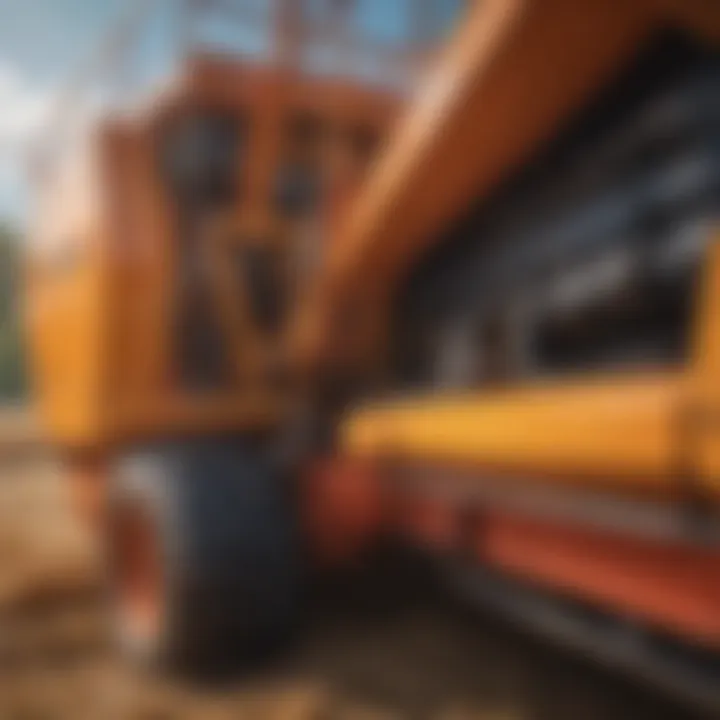
When it comes to modern agriculture, making sense of the variances in inline square balers is truly vital. Each type of baler comes with its own unique characteristics, designed to adapt to various farming needs. These types cater not only to the different kinds of crops but also to the necessities of diverse agricultural operations. By understanding the mechanics behind vertical and horizontal balers, farmers can make a well-informed choice that boosts efficiency in their operations and reduces waste.
Vertical Baler Designs
Vertical balers are often the go-to choice for those who need compact bales that are easy to handle and store. Unlike their horizontal counterparts, vertical balers operate with a really simple mechanism that compresses the material from the top down. This configuration makes it easier for the operators, especially in tight spaces.
One of the crucial benefits of vertical balers is their efficiency in producing smaller, denser bales. Farmers can easily stack these bales, ensuring that storage space is maximized. This is especially handy for operations where space is a premium, like smaller farms or those that focus on specialty crops. Furthermore, with some models being more lightweight, they can be towed behind smaller tractors, allowing for more flexibility in the field.
"Vertical balers often serve smaller operations where space and ease of handling are critical."
Another aspect to consider is durability. Good quality vertical balers are built to withstand the rigors of agricultural use. Farmers can expect that with regular maintenance, these machines will have a long life. But it’s important to point out that they may lack some features that come with horizontal designs, especially in terms of width and bale size.
Horizontal Baler Configurations
Horizontal balers, on the contrary, cater to larger operations where speed and volume are key factors. Designed for high-capacity output, these machines can process large quantities of material quickly. By compressing the material horizontally, they allow for the production of larger bales, which can be advantageous for high-yield farms.
The design of horizontal balers often includes advanced features such as automatic tie systems and electronic controls, which substantially reduce the labor required. This automation can mean a lot when it comes to time saved during harvest season. The operator can focus on other pressing tasks, enhancing overall productivity.
A striking advantage is that these balers are often more versatile; they can handle a wide variety of materials, from hay and straw to different types of forage. However, they do tend to require more horsepower, which can be a consideration for farmers with limited tractor capabilities.
In summary, while both vertical and horizontal inline square balers have their own sets of advantages, the choice largely depends on individual farming circumstances. From the scale of the operation to the crop types in question, understanding these distinctions is critical for any modern farmer looking to optimize their baling process.
Mechanics of Operation
Mechanics of operation plays a pivotal role in understanding inline square balers. This segment of the article sheds light on how these machines function and the intricate systems that enable them to deliver high efficiency during harvesting. Grasping the mechanics allows farmers and agricultural enthusiasts to appreciate not only the technology but also the substantial benefits it brings to modern farming practices.
Baling Process Overview
The baling process is a well-coordinated ballet of machinery and mechanics. It begins when the crop material—whether it’s hay, straw, or other forage—is gathered by the pickup mechanism. The material is then transported into the chamber, where it gets compressed into bales. To put it in simpler terms, it’s like taking a mountain of loose material and transforming it into neatly packaged bricks, ready for transport or storage.
The efficiency of this process is notable. Inline square balers cut down on labor and time, significantly speeding up the usually long and tedious task of baling. Farmers can expect to see improved productivity, allowing them to focus on other aspects of their operations.
Loading and Threading Systems
One vital aspect that might easily slip under the radar is the loading and threading systems of inline square balers. These systems are essentially the unsung heroes that ensure a smooth flow during the baling process. Different models incorporate various designs for loading the crop into the baler. Some use conveyor belts, while others might employ augers or even rotary systems.
Furthermore, the threading mechanism is critical for initiating the formation of the bale. The twine or net wrap is carefully threaded through the mechanism, making sure the bales are securely tied. An unchained, wild thread could lead to a disaster, causing loose bales that might unravel during transport. Here’s what to consider:
- Type of Loading System: Choose a loader that fits with the specific crop type and density.
- Adjustable Tension: Some balers allow for tension adjustments, providing flexibility for different crops and conditions.
- Maintenance: Regular checks on the threading system help avoid breakdowns during critical times.
Bale Forming Mechanisms
Bale forming mechanisms are the crux of how inline square balers produce their unique square shape. Each baler comes equipped with its own set of forming chambers, which compact the material into a uniform size. This uniformity isn’t just a luxury; it’s essential for easy stacking and transport.
Some balers even provide options for different sizes of bales, allowing farmers to customize based on market needs or storage capabilities. The mechanism is primarily a matter of angles and pressure—like putting a raw piece of clay into a mold to create pottery. The better the forming mechanism, the more consistent the bales.
- Forming Chamber Design: Different designs can yield variations in density and shape.
- Control Systems: Advanced models come with control systems that monitor compression ratios, ensuring optimal results every time.
In summary, the mechanics of operation in inline square balers are foundational to their effectiveness. Understanding how these machines work is not just academic; it has real-world implications. Farmers who comprehend these elements can make informed decisions, adopting strategies that optimize their operation's output.
Benefits of Inline Square Balers
The role of inline square balers in modern agriculture cannot be overstated. These machines do not just streamline the baling process; they significantly enhance overall efficiency, reduce costs, and offer practical advantages in terms of space management. Farmers are increasingly recognizing that these balers are vital tools to optimise their operations. The benefits they bring, from labor savings to improved harvesting efficiency, can be game-changers for agricultural enterprises.
Increased Efficiency in Harvesting
When you look at the baling process, efficiency is key. Inline square balers make this task considerably smoother. They allow seamless integration with harvesting equipment, enabling farmers to collect, compress, and package crop materials swiftly.
- Continuous Flow: The design facilitates a near-continuous flow of material, meaning that the machine can operate without frequent interruptions. This leads to fewer delays, whether you're dealing with hay, straw, or other types of crop residues.
- High Throughput Rates: Many of today’s models are engineered to achieve high throughput rates. This means a farmer can bale more in less time, allowing more time for other critical tasks around the farm.
- Quality of Bales: The bales produced are typically denser and uniform, which can further improve transportation and storage efficiency. Dense bales take up less space, are easier to transport, and maintain quality over time due to reduced air exposure.
Minimized Labor Costs
Let's face it: the fewer hands needed, the better for the margins. Inline square balers offer the prospect of significant labor savings. They allow one operator to manage the baling process effectively without needing an army of workers.
- Less Manual Intervention: Automating various aspects of the baling process means that fewer personnel are required to operate the machinery. This directly translates to lower labor expenses.
- Multi-tasking Capabilities: With state-of-the-art automation options, these machines can perform various tasks simultaneously. An operator can often handle loading and baling, which cuts downtime and boosts productivity.
"A single inline square baler can replace the work of multiple manual laborers, which in today's economy, is not just a convenience but a necessity."
Space-Saving Bale Design
An undeniable advantage of inline square balers is their unique bale design. Unlike traditional round bales, square bales stack better and are easier to store.
- Stackability: Square bales can be neatly stacked, utilising vertical space more efficiently. This can be a boon during off-seasons when storage becomes a priority.
- Standardized Sizes: The uniform nature of these bales also means that farmers can more easily plan their storage capacities. Whether it’s a barn or an outdoor storage area, square bales fit in without wasting any precious real estate.
- Ease of Handling: Additionally, these bales can be handled quickly with appropriate machinery, further enhancing the ease of movement and storage on farms.
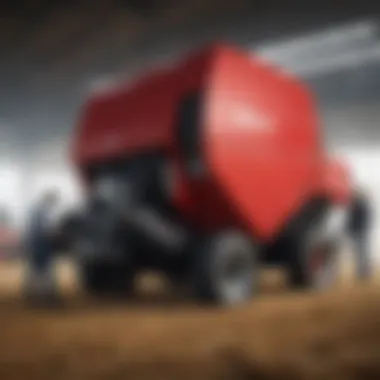
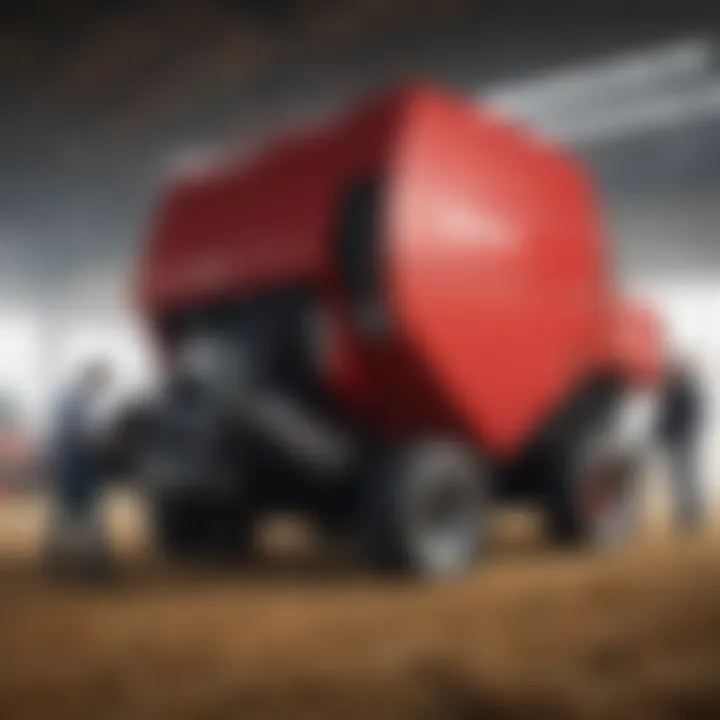
In summary, the benefits of inline square balers speak volumes to their relevance in today’s agricultural landscape. They are instruments of efficiency, cost savings, and practical space management—qualities every farmer should keep in their back pocket when considering the overall operational strategy.
Maintenance Considerations
Maintaining inline square balers might not seem like the most glamorous aspect of farming, but it can mean the difference between a smooth operation and a setback that costs time and money. Regular maintenance is essential to keep these machines working efficiently. When neglect becomes the norm, it can lead to costly repairs and even downtime during critical harvesting periods.
Routine Inspection and Upkeep
Routine inspection involves assessing various components to identify potential issues before they escalate. Farmers should develop a regular schedule, perhaps checking the baler at the beginning and end of each harvest day. Key areas to focus on include:
- Hydraulic systems: Check for leaks or inconsistencies which can cause operational failures.
- Belts and chains: Ensure they are properly tensioned and free from wear and tear.
- Knives and cutting blades: Sharp blades ensure a clean cut, improving efficiency and reducing strain on the baler.
- Safety features: Regular checks on safety guards and emergency stops can safeguard against accidents.
Adjusting components as needed can greatly contribute to the overall longevity of the baler. By staying proactive, farmers can avoid larger issues down the line.
Repair and Replacement Parts
Every machine will face wear and tear, and inline square balers are no exception. Having access to the correct repair and replacement parts is crucial for quick fixes. Knowing when to replace parts is vital for maintaining performance efficiency.
Common parts that may need periodic replacement include:
- Gearboxes: As they age, gearboxes can wear out leading to inefficiencies. Replacing them as needed ensures smooth operation.
- Rollers and tines: These can become damaged during use and must be replaced to maintain the quality of bales.
- Pulleys and belts: The heart of a baler’s operation can falter if these parts are not in good shape.
Staying informed about where to get quality replacement parts, whether locally or online, can save time and hassle.
"The best way to predict the future is to create it." - Peter Drucker
In sum, by prioritizing maintenance thoroughness, farmers not only enhance the longevity of their inline square balers but also contribute to a smoother and more efficient harvesting season. Simple checks and timely repairs can lead to significant savings and improvements in operations.
Technological Advancements in Inline Square Balers
The world of inline square balers has undergone a profound transformation in recent years. Technological advancements in this domain not only boost productivity but also significantly enhance the operational features that modern farmers demand. Understanding these developments is crucial, as they shape the efficiency and effectiveness of harvesting processes, thereby directly impacting the farm's bottom line.
With the growth of agricultural technology, inline square balers have started incorporating various innovations that streamline their operation. It's not just about making bales anymore; it's about how these machines integrate into the broader agricultural framework. By improving both functionality and user experience, these advancements play a pivotal role in how agricultural outcomes are achieved today.
Automation Features
One of the standout advancements in inline square balers is automation. Modern balers now often feature systems that allow for greater autonomy during the baling process. This means that farmers can operate these machines with less manual intervention, which is a game changer in busy harvesting seasons.
- Self-Monitoring Systems: Some of the latest balers come equipped with sensors that monitor process parameters such as pressure and tension. This data enables automatic adjustments, ensuring optimal performance under varying conditions.
- Remote Operation: The integration of remote control capabilities allows operators to manage balers from a distance. This not only enhances convenience but also improves safety, as farmers can be far from the machine when it operates.
- Data Analytics: Through the use of IoT and data technologies, balers can collect and transmit operational data. Analyzing this data helps farmers make informed decisions that can lead to cost savings and improved outcomes.
Automation, therefore, not only cuts down on labor costs but also minimizes human error, leading to a more efficient baling process.
Integration with Precision Agriculture Tools
As agriculture becomes increasingly data-driven, the integration of inline square balers with precision agriculture tools has gained traction. This integration is essential for maximizing efficiency and improving overall crop management.
- GPS Functionality: Many new balers include GPS technology, allowing for precise tracking of field operations. This ensures that every acre is efficiently harvested, minimizing waste.
- Variable Rate Technology (VRT): This allows farmers to adjust the amount of inputs—such as seeds, fertilizers, or even the density of bales—based on specific field conditions. This tailored approach optimizes resource usage and enhances yield potential.
- Compatibility with Drones and Smart Equipment: Drones can scout fields to assess crop health, providing data that can be utilized by balers to make better real-time decisions. Smart equipment that communicates with balers can also aid in optimizing all harvesting and processing tasks based on current conditions.
Such advancements in technology ensure that inline square balers are not just standalone machines but rather integral components of a larger, interconnected agricultural ecosystem. This synergy enhances efficiency, reduces costs, and contributes to more sustainable farming practices.
"The future of farming lies at the intersection of tradition and technology, where each tool complements the other to ensure precision and productivity."
As inline square balers continue to evolve technologically, they promise to help farmers meet the escalating demands of modern agriculture while also promoting sustainability and profitability.
Economic Impact on Farmers
The evolution of inline square balers has sparked significant changes in the agricultural sector. Understanding their economic impact is crucial for anyone involved in farming, from small family farms to large agribusinesses. Inline square balers not only enhance operational efficiency but also contribute to the broader economic landscape of farming. Their role in maximizing productivity while minimizing costs cannot be overstated, making it essential to delve into this topic.
Cost-Benefit Analysis
When considering any agricultural equipment, conducting a cost-benefit analysis is key. Inline square balers bring with them an initial investment, but the real question is whether the benefits outweigh the costs.
- Initial Costs: The price of an inline square baler can be considerable. Farmers must weigh the upfront expense against what they expect to gain in productivity.
- Efficiency Gains: These balers are designed to handle large amounts of crop material quickly. This increased throughput can lead to faster harvesting, allowing farmers to capitalize on good weather or labor availability.
- Labor Savings: With enhanced automation features in many modern balers, fewer hands are needed to get the job done. This speaks volumes in reducing the overall labor cost, which can be significant, especially during peak harvest times.
- Bale Quality: High-quality bales have a direct effect on storage cost and feed efficiency. The compression and size uniformity provided by inline square balers often results in better-quality bales, reducing wastage.
In essence, if a farmer invests in an inline square baler, they could expect a more streamlined operation, leading to a better bottom line in the long run.
Long-Term Investment Perspectives
Investing in inline square balers can be viewed as a long-term strategy, and like any asset, they come with both risks and rewards. Farmers need to think beyond immediate costs and consider future agricultural trends and personal operational goals.
- Resale Value: Inline square balers maintain their value better than many other types of farm equipment. Assuming good maintenance is factored in, these machines can provide a return if sold after several years.
- Adapting to Market Demand: As agricultural practices shift towards sustainability and higher yields, having modern equipment like inline square balers aids in meeting these demands. This readiness opens doors for premium pricing on high-quality hay or straw.
- Economic Resilience: Farms that adopt technology, including inline square balers, are often more adaptable to fluctuations in the market, whether it’s due to climatic changes or global competition. Such resilience can mean the difference between thriving and just surviving in tough years.
- Insurance and Financing Options: Many financial institutions recognize the value of such machinery. This can lead to favorable terms for loans or insurance policies due to the expected longevity and utility of inline square balers.
Inline square balers are not just a cost; they are an investment in the future of farming. Their capacity to improve both productivity and profitability marks them as vital in modern agriculture.


Environmental Considerations
Understanding the environmental impact of inline square balers is vital for both current and future agricultural practices. Farmers are increasingly aware of the need to harmonize productivity with ecological responsibility. This section will shed light on various environmental considerations that come into play when using inline square balers, particularly focusing on sustainable practices and their effect on soil and crop health.
Sustainability in Baling Practices
When we talk about sustainability in baling, it’s all about ensuring that the methods we use now do not compromise the ability of future generations to meet their farming needs. Inline square balers can contribute positively if operated with an eye toward sustainable practices.
- Use of Biodegradable Materials: Operators can opt for twine or net wrap made from biodegradable materials. By using such alternatives, farmers are reducing the amount of plastic left in fields, aligning their practices with eco-friendly initiatives.
- Energy Efficiency: Modern balers are designed for optimal fuel consumption. Efficient machinery reduces carbon emissions and fuel costs, making the entire baling process less taxing on the environment. This not only keeps more money in farmers' pockets but also assists in decreasing their carbon footprint.
- Multi-Functional Capabilities: Some inline balers have features that allow for integrating cover cropping and other restorative practices right into the baling process. This synergy between operations ensures that soil health is preserved while maintaining the productivity of the farm.
"Sustainability isn't merely a buzzword in agriculture; it’s a path forward for future generations of farmers."
Impact on Soil and Crop Health
Baling directly affects soil and crop health, and farmers must consider these impacts to promote long-term productivity.
- Soil Compaction: Heavy machinery can lead to soil compaction, which adversely affects root development and water retention. Inline square balers, if improperly used, can add stress to the land. Therefore, it is essential to operate such machinery under optimal moisture conditions and on well-maintained pathways to mitigate these effects.
- Nutrient Management: When crops are harvested, residues can either be left on the field to decompose or collected. Leaving residue helps with nutrient recycling, thus benefiting future crops. Inline balers designed to handle residual materials can essentially perform two roles—harvesting and leaving behind essential nutrients for the soil.
- Biodiversity: It's vital to ensure that extensive baling does not compromise the land’s biodiversity. The use of inline square balers in diverse cropping systems encourages the maintenance of healthier ecosystems, as they can be adapted to work with multiple crop types without harming the overall health and diversity of the flora and fauna.
In sum, environmental considerations surrounding inline square balers are multifaceted. By centering operations on sustainable practices and keeping an eye on the health of the soil and crops, farmers can ensure they’re part of the solution rather than the problem.
Case Studies of Inline Square Baler Usage
The real-world application of inline square balers sheds light on their effectiveness and versatility in various agricultural settings. Case studies not only illustrate how these machines can transform farm operations, but they also highlight best practices that can be adopted by others in the industry. By examining different scenarios and outcomes, we can gather valuable insights into their efficiency, adaptation to different climates, and the lessons learned from farmers who have taken the plunge into utilizing these machines.
Successful Implementations in Diverse Climates
Farming is never a one-size-fits-all endeavor. Each climate presents its own unique challenges and opportunities. Inline square balers have demonstrated their robust adaptability across diverse conditions.
For example:
- In the midwestern United States, farmers handling alfalfa noted that using these balers allowed them to cut down on drying time significantly. The baler's design helps preserve the nutritional value of the forage, making it a preferred choice.
- In Australia, operators in arid regions found that these balers make it possible to efficiently complete the baling process during limited weather windows. The compact bales are easier to store and transport, hurdles that are often overlooked in the planning stages.
This flexibility leads to more effective resource usage, which in turn can even enhance soil health. Farmers frequently cite the ease of adjustment settings on their balers to cater to local crop types and moisture levels, further attesting to the adaptability of these machines.
Lessons Learned from Early Adopters
Farmers who jumped on the inline square baler bandwagon early on often found themselves leading the pack in terms of productivity gains and cost savings. Their experiences provide invaluable lessons for newcomers considering these machines. Some critical takeaways from these early adopters include:
- Regular Maintenance: Many farmers reported that their initial lack of attention to maintenance led to unforeseen breakdowns. A watchful eye on lubrication and necessary adjustments can keep machines humming smoothly.
- Investing in Training: Understanding the intricacies of the baler operation often pays dividends. Early users who prioritized training for their staff boasted less downtime and higher output.
- Adaptation of Practices: Some found that integrating their baler's capabilities into existing operations required a mindset shift. Those who embraced experimentation with their harvesting strategies often saw substantially better results.
"It’s like learning to dance - first, you stumble, but with practice, you glide across the floor. The same goes for using balers efficiently."
In closing, the accumulated knowledge from case studies presents useful strategies and a clearer vision of how inline square balers can reshape farming practices in modern agriculture. Such evidence-based insight is essential for anyone entering the world of baling, to avoid common pitfalls and capitalize on the many benefits these machines offer.
Future of Inline Square Balers
Looking ahead, the future of inline square balers reveals itself as a vital area to explore for anyone involved in agriculture. As the demand for efficiency grows and farmers seek to optimize their operations, understanding the upcoming advancements in baler technology becomes increasingly important. This section will delve deep into the trends and innovations that could define the landscape of agricultural machinery in years to come.
Trends Shaping the Industry
Several significant trends are currently molding the direction of inline square balers. These include:
- Smart Technology Integration: Technology is becoming an integral part of agriculture. The incorporation of sensors and IoT devices allows for real-time monitoring of baling processes, which enhances decision-making and increases overall efficiency.
- Environmentally Friendly Practices: Sustainable farming is more than a buzzword; it’s becoming a requisite. Farmers are seeking balers that not only increase productivity but also minimize environmental impact. This could mean adopting machines that utilize less energy or manage waste more effectively.
- Customization and Modularity: As farms take on a variety of crops, there is a growing need for balers that can be tailored to specific requirements. Companies are developing models that allow for adjusting sizes and configurations based on the types of material being baled.
- Rising Automation: Automation in agriculture is set to rise. Balers with automated systems not only complete tasks more efficiently, but they also reduce labor requirements on farms. This trend simplifies operations and allows farmers to focus on other critical areas of their business.
"The introduction of smart technology in balers will revolutionize the way farmers approach their harvesting and storage processes."
Each of these trends reflects a significant shift towards innovation within the industry. Farmers need to stay abreast of these changes to make informed decisions about their equipment and practices.
Predictions for Agricultural Innovations
Looking into the future, several predictions emerge regarding agricultural innovations that can transform the utilization of inline square balers:
- Enhanced Data Analytics: As big data continues to influence agriculture, balers will equipped with advanced analytics features. This will allow farmers to analyze performance metrics affected by weather patterns, soil quality, and other variables to optimize their operations.
- AI-Driven Operations: The advent of artificial intelligence could streamline baling processes further. AI can predict issues before they become problems, creating a reliability that farmers greatly need. Imagine a baler that recognizes when bales are improperly formed and adjusts automatically.
- Improved Safety Features: With an increasing focus on workplace safety, future balers might include enhanced safety mechanisms. This could be in the form of automatic shut-off features or sensors that detect human presence, minimizing accidents in the field.
- Sustainable Material Usage: Innovations may lead to balers that use biodegradable materials in their design. As environmental regulations become stricter, such measures could gain traction, reducing the ecological footprint of agricultural practices.
As we move further into our technologically advanced age, predictions like these offer a glimpse of what might come to fruition. Farmers have always adapted to new tools, and with inline square balers set to evolve, one can only imagine the remarkable changes that await.
Culmination
In this article, we have journeyed through the multifaceted aspects of inline square balers, focusing on their significance in modern farming practices. Inline square balers play a crucial role in optimizing efficiency, reducing operational costs, and enhancing the overall productivity of agricultural activities.
Summary of Key Points
Throughout this discussion, several core themes have emerged:
- Efficiency Gains: Inline square balers have revolutionized the way farmers process hay and straw, allowing for faster and more uniform operations compared to traditional balers. The design and technology behind these machines enable them to perform at optimum levels, reducing time spent in the field.
- Cost-Effectiveness: By minimizing labor costs and increasing harvesting efficiency, these balers offer an economic advantage that many farmers find hard to ignore. The initial investment might seem significant, but the long-term savings make it a wise decision.
- Sustainability: With advancements in technology, inline square balers contribute to sustainable farming practices. Their efficient use of resources and ability to produce compact bales mean less waste and better land management.
- Future Innovations: The integration of smart technology and automation indicates a promising future for inline square balers. Farmers can anticipate further improvements that will continue to streamline operations and increase yields.
Final Thoughts on Utilization
Utilizing inline square balers is not just about having the latest equipment; it’s a decision that impacts the entire farming operation—from labor management to environmental stewardship. Farmers willing to adapt these advanced solutions will find a plethora of benefits in their seamless integration into everyday practices. It is crucial to stay updated on technological advancements that emerge in this space, as they frequently offer new solutions to age-old problems.
"The future of agriculture relies on our ability to embrace technology and efficient practices. Inline square balers are a step in that direction."
As the agricultural industry continues to evolve, those who invest in inline square balers can expect to reap the rewards in productivity and sustainability. The keys to mastering their utilization lie not only in understanding the machines themselves but also in recognizing how they fit into the broader scope of agricultural innovation. Taking the plunge and implementing these balers could very well be the turning point for a farm, positioning it for success in today's competitive landscape.



